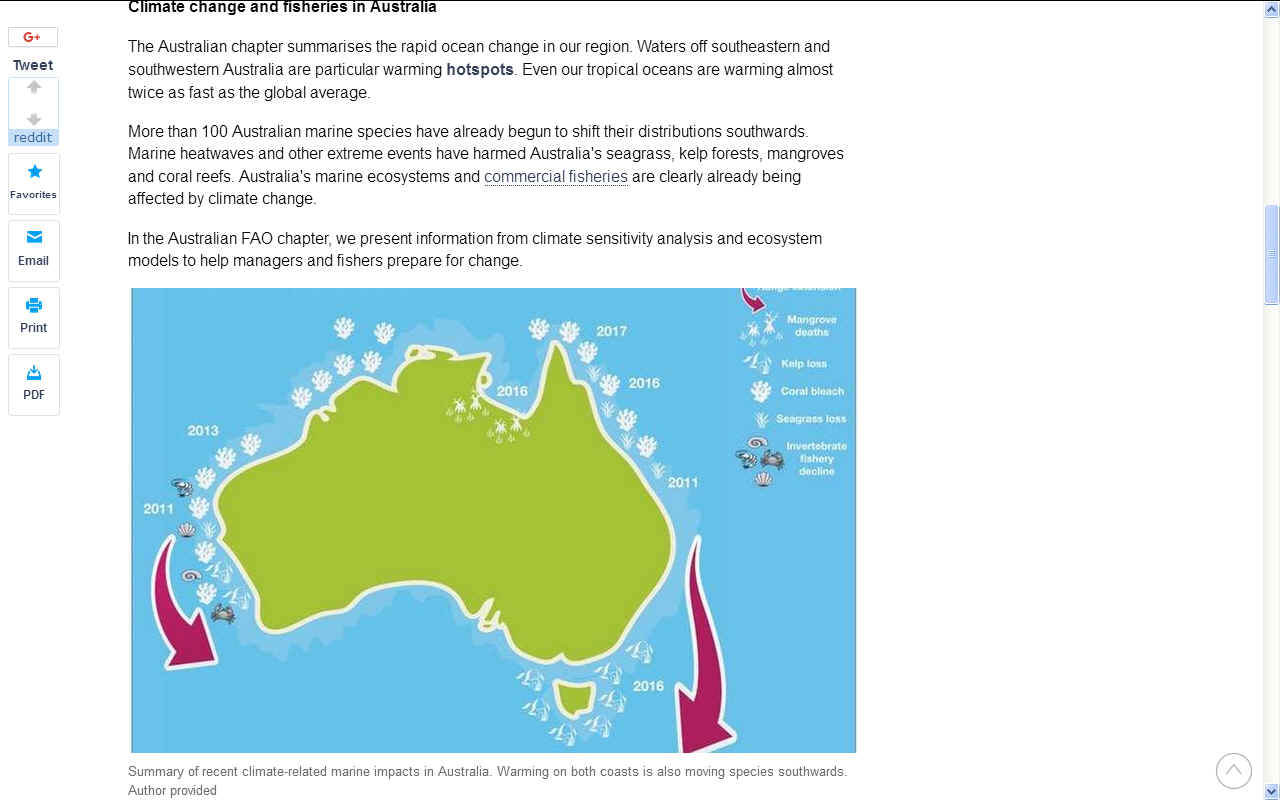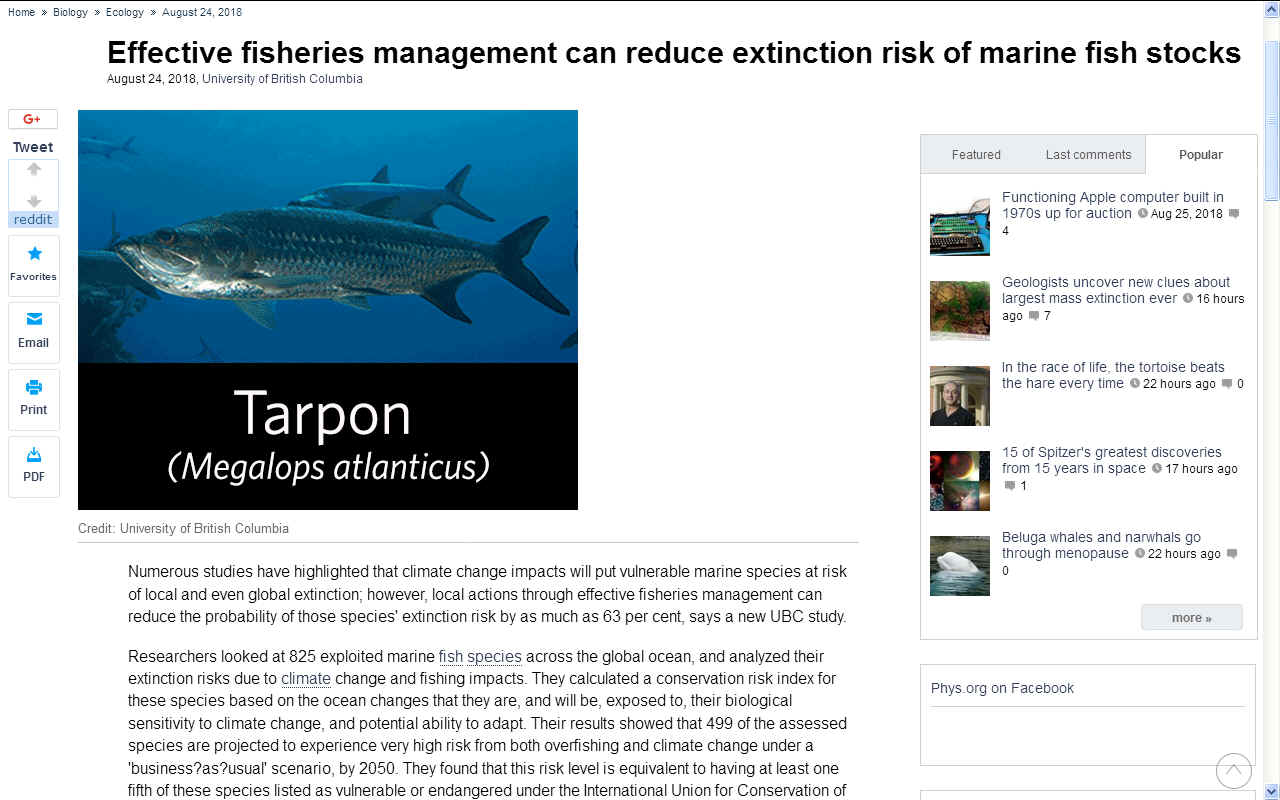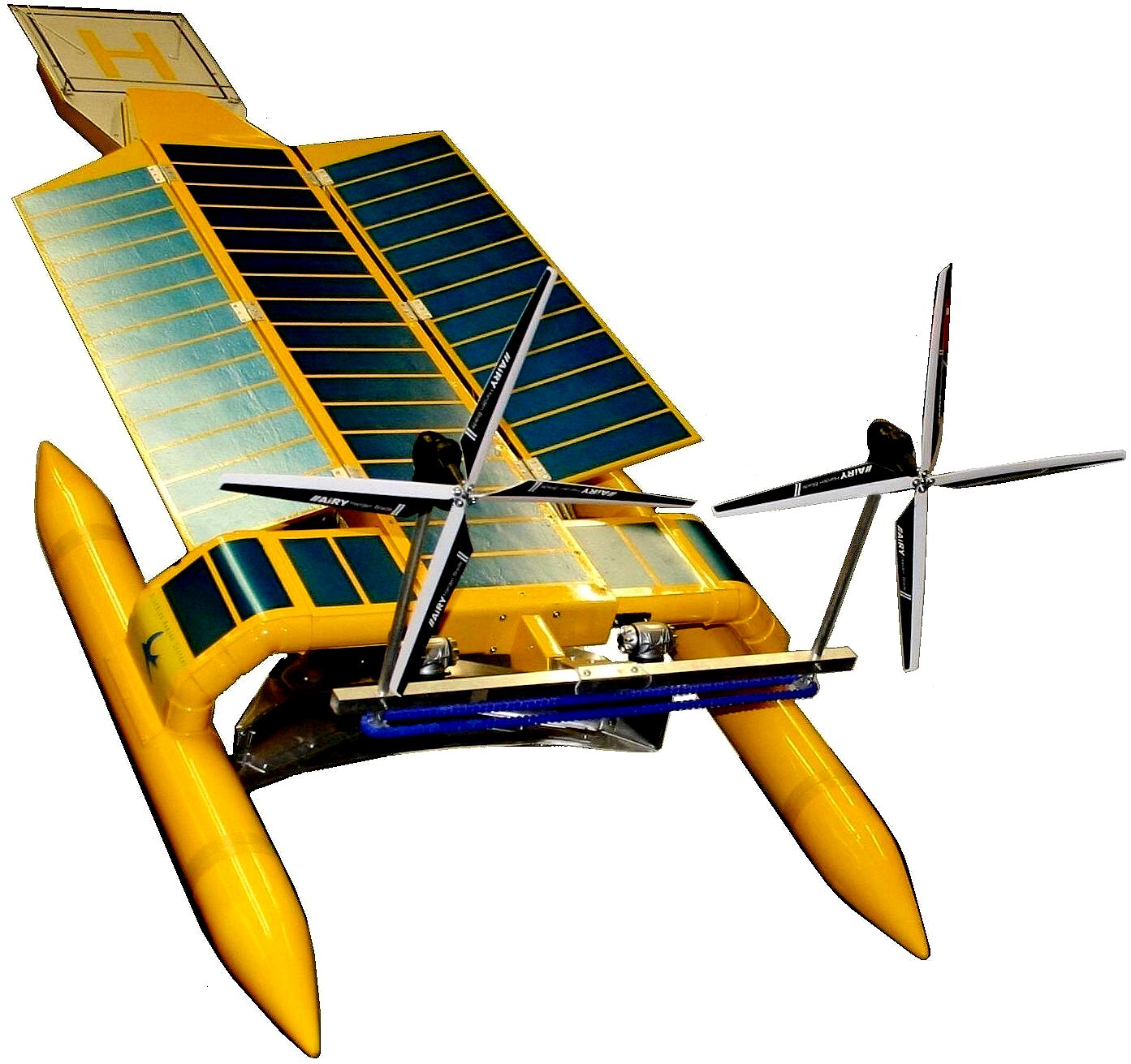|
REPORTS - FISHERIES
MANAGEMENT & CLIMATE CHANGE
ABOUT - CONTACTS -
DONATE - FOUNDATION -
HOME - A-Z INDEX

AUSTRALIA -
Summary of recent climate-related marine impacts in Australia. Warming on both coasts is also moving species southwards.
PHYSICS UNIVERSITY BRITISH COLUMBIA - AUGUST 24 2018
Numerous studies have highlighted that climate change impacts will put vulnerable marine species at risk of local and even global extinction; however, local actions through effective
fisheries management can reduce the probability of those species' extinction risk by as much as 63 per cent, says a new UBC study.
Researchers looked at 825 exploited marine fish species across the global
ocean, and analyzed their extinction risks due to climate change and
fishing impacts. They calculated a conservation risk index for these species based on the ocean changes that they are, and will be, exposed to, their biological sensitivity to climate change, and potential ability to adapt. Their results showed that 499 of the assessed species are projected to experience very high risk from both overfishing and climate change under a 'business-as-usual' scenario, by 2050. They found that this risk level is equivalent to having at least one fifth of these species listed as vulnerable or endangered under the International Union for Conservation of Nature (IUCN) Red List of Endangered Species.
"Effective fisheries management plans, coupled with actions to limit greenhouse gas emissions, both separately, but especially in tandem, would have an immediate effect on the number of marine species that face extinction," said William Cheung, lead author and Associate Professor in the Institute for the Oceans and Fisheries at the University of British Columbia. "We can save hundreds of fish stocks from becoming endangered species with sustainable fisheries and low
greenhouse gas
emissions."
Sharks and rays have the highest extinction risk under 'business as usual' fishing and climate change scenarios. The Dusky smoothhound
shark (Mustelus canis) is expected to be the hardest hit, with other species at high risk including Dungat grouper (Epinephelus goreensis), Tarpon (Megalops atlanticus), and Law croaker (Pseudotolithus senegallus). Many of these species are already considered endangered for non-climatic reasons, such as
overfishing. This study indicated that the estimated combination of climate and fishing risks means that they are even more likely to become extinct.
The areas with more
at-risk species due to climate change are in the tropical and subtropical oceans, while those species at risk due to fishing are distributed more broadly, with higher concentration in the North
Atlantic and South
Pacific
Ocean.
"Our study showed the need to support adaptation to climate change, while insuring effective fisheries management in these regions," said Gabriel Reygondeau, a postdoctoral fellow at UBC's Institute for the Oceans and Fisheries and co-author on the paper. "Some actions are already underway; for example, nine nations and the
European Union agreed to prohibit commercial fishing in the central
Arctic Ocean for at least 16 years starting in 2017. Similar proactive planning for the potential interactions between climate change and fishing is needed."
PHYSICS.ORG 11 JULY 2018 - WARMING OCEANS & AUSTRALIA'S FISHERIES
A new United Nations report on fisheries and
climate change shows that Australian marine systems are undergoing rapid environmental change, with some of the largest climate-driven changes in the Southern Hemisphere.
Reports from around the world have found that many fish species are changing their distribution. This movement threatens to disrupt fishing as we know it.
While rapid change is predicted to continue, researchers and managers are working with fishers to ensure a sustainable industry.
Lessons from across the world
Large climate-driven changes in species distribution and abundance are evident around the world. While some species will increase, global models project declining seafood stocks in tropical regions, where people can least afford alternative foods.
The global concern for seafood changes led the UN Food and Agriculture Organisation (FAO) to commission a new report on the impacts of climate change on fisheries and
aquaculture. More than 90 experts from some 20 countries contributed, including us.
The report describes many examples of climate-related change. For instance, the northern movement of European mackerel into Icelandic waters has led to conflict with more southerly fishing states, and apparently contributed to Iceland's exit from negotiations over its prospective
European Union membership.
Changes in fish abundance and behaviour can lead to conflicts in harvesting, as occurred in the Maine lobster fishery. Indirect effects of climate change, such as disease outbreaks and algal blooms, have already temporarily closed fisheries in several countries, including the
United States and
Australia.
All these changes in turn impact the people who depend on fish for food and livelihoods.
Climate change and fisheries in Australia
The Australian chapter summarises the rapid ocean change in our region. Waters off southeastern and southwestern Australia are particular warming hotspots. Even our tropical oceans are warming almost twice as fast as the global average.
More than 100 Australian marine species have already begun to shift their distributions southwards. Marine heatwaves and other extreme events have harmed Australia's seagrass, kelp forests, mangroves and
coral
reefs. Australia's marine ecosystems and commercial fisheries are clearly already being affected by climate change.
In the Australian FAO chapter, we present information from climate sensitivity analysis and ecosystem models to help managers and fishers prepare for change.
We need to preparing climate-ready fisheries, to minimise negative impacts and to make the most of new opportunities that arise.
Experts from around Australia have rated the sensitivity of more than 100 fished species to climate change, based on their life-history traits. They found that 70% of assessed species have moderate to high sensitivity. As a group, invertebrates are the most sensitive, and pelagic fishes (that live in the open ocean sea) the least.
A range of ecosystem models have also been used to explore how future climate change will impact Australia's fisheries over the next 40 years. While results varied around Australia, a common projection was that ecosystem production will become more variable.
As fish abundance and distribution changes, predation and competition within food webs will be affected. New food webs may form, changing ecosystems in unexpected ways. In some regions (such as southeastern Australia) the ecosystem may eventually shift into a new state that is quite different to today.
How can Australian fisheries respond?
Our ecosystem models indicate that sustainable fisheries are possible, if we're prepared to make some changes. This finding builds on Australia's strong record in fisheries management, supported by robust science, which positions it well to cope with the impacts of climate change. Fortunately, less than 15% of Australia's assessed fisheries are overfished, with an improving trend.
We have identified several actions that can help fisheries adapt to climate change:
* Management plans need to prioritise the most sensitive species and fisheries, and take the easiest actions first, such as changing the timing or location of operations to match changing conditions.
* As ecosystem changes span state and national boundaries, greater coordination is needed across all Australian jurisdictions, and between all the users of the marine environment. For example, policy must be developed to deal with fixed fishing zones when species distribution changes.
* Fisheries policy, management and assessment methods need to prepare for both long-term changes and extreme events. Australian fisheries have already shifted to more conservative targets which have provided for increased ecological resilience. Additional quota changes may be needed if stock productivity changes.
* In areas where climate is changing rapidly, agile management responses will be required so that action can be taken quickly and adjusted when new information becomes available.
* Ultimately, we may need to target new species. This means that Australians will have to adapt to buying (and cooking) new types of fish.
Researchers from a range of organisations and agencies around Australia are now tackling these issues, in partnership with the fishing industry, to ensure that coastal towns with vibrant commercial fishing and aquaculture businesses continue to provide sustainable seafood.

PHYSICS.ORG
JULY 2018 - Fisheries management could reduce the risk of
extinction of some fish species.
LINKS
& REFERENCE
https://phys.org/news/2018-08-effective-fisheries-extinction-marine-fish.html
https://phys.org/news/2018-07-oceans-australia-fishing-industry.html

OCEAN
CONDITIONER - The fishing industry stands to benefit the
most from ocean conditioning and healthier oceans. SeaVax
is designed to operate in fleets
to target sea-borne waste before it settles on the ocean floor
where nobody can recover it. There is nothing like it in
existence today, though thankfully, other ideas for trapping plastic waste
are being developed in tandem, such as that of Boyan
Slat and the Seabin.
This
website is provided on a free basis as a public information
service. copyright © Cleaner
Oceans Foundation Ltd (COFL) (Company No: 4674774)
2018. Solar
Studios, BN271RF, United Kingdom.
COFL
is a charity without share capital.
|

